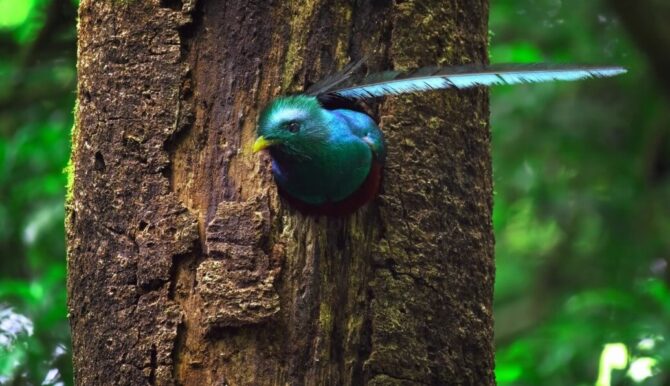Birds are magnificent creatures, and many come with different features. There is a category of birds with fascinating, long beaks which serve a good purpose.
Some birds use their long beaks to feed, others as a weapon to protect themselves, and we have those for which a long beak is a swimming tool.
Some of these beaks are also quite beautiful.
Examples of birds with long beaks include common species like the kiwi, toucan, eagle, hornbill, royal flycatcher, and jabiru, to mention a few.
Here’s a list of 20 fascinating long-beak birds and some interesting facts you should know about them, with pictures.
Birds with Long Beaks
1. Marabou Stork
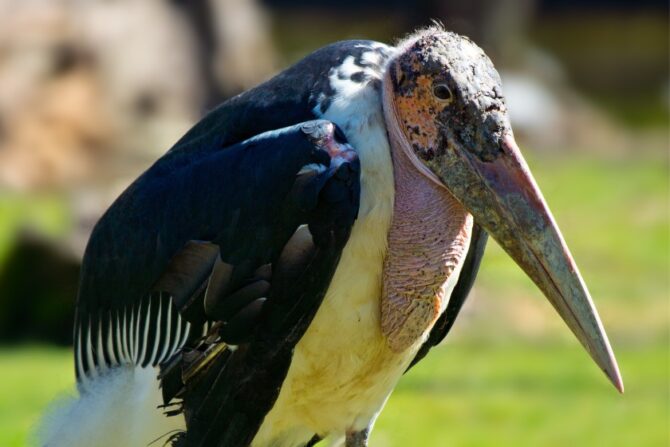
- Scientific Name: Leptoptilos crumenifer
- Length: 4.99 ft
- Weight: 20 pounds
- Beak Length: 10.4 to 13.8 inches
- Range: Sub-saharan Africa
The Marabou stork is a member of the Ciconiidae (stork) family located in Sub-saharan Africa.
You can also find it in the Middle East. This is a very large bird with a noticeably long wingspan, and not surprisingly, its beak is also long.
Depending on the individual, it measures up to 13.8 inches, sometimes even longer.
As a scavenger, the Marabou stork needs its bill to bite into carrion. This bird sometimes eats live animals, but its main diet consists of carrion.
Its scavenger habit also explains the lack of feathers on the face, as this prevents dead meat from sticking. The Marabou’s bill is dark with a yellowish tip.
Related: Meet The 20 Ugliest Birds In The World
2. Kagu
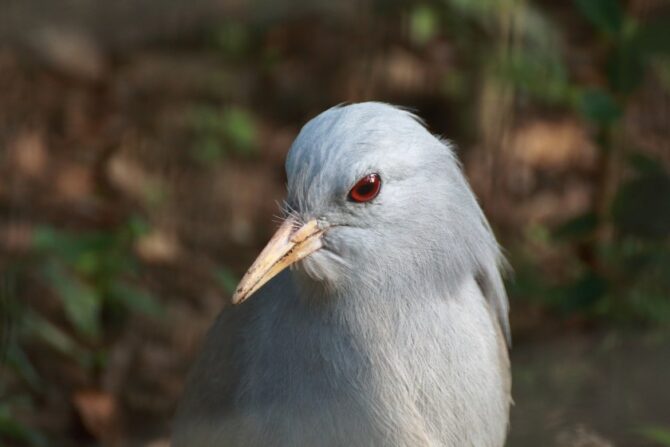
- Scientific Name: Rhynochetos jubatus
- Length: 21.5 inches
- Weight: 25 to 39 pounds
- Beak Length: 2 to 3.1 inches
- Range: New Caledonia
The kagu is a small, endangered bird, the only surviving member of the Rhynochetidae family and the Rhynochetos genus.
It can be found only in New Caledonia. The kagu’s distinguishing feature is its long legs, but we can’t also ignore the beak.
The latter may seem short compared to bigger birds, but on the level of small birds, it is long.
The kagu uses its beak to search for food. One of its preferred meals is the snail, and it uses its bill to pick its prey.
It also wades through leaves with it and goes into cracks, all in search of food.
The kagu is a shy bird, and you may hardly see it in the forests where it lives. Camouflage is its biggest defense against predators.
3. American Flamingo

- Scientific Name: Phoenicopterus ruber
- Length: 47 to 57 inches
- Weight: 6.2 pounds
- Range: North America
The American flamingo is a member of the Phoenicopteridae family, and it is the only flamingo that’s a native of North America.
It is also called the Caribbean flamingo, though it can be found outside the Caribbean.
This bird can easily be recognized with its long legs, pink plumage, an equally long neck, and the beak.
Every part of the American flamingo reflects its lifestyle and its need for survival.
The pink plumage comes from its diet, which consists of crustaceans, algae, and small plants instead of fish. The legs, neck, and beak help in finding food.
4. Shoebill
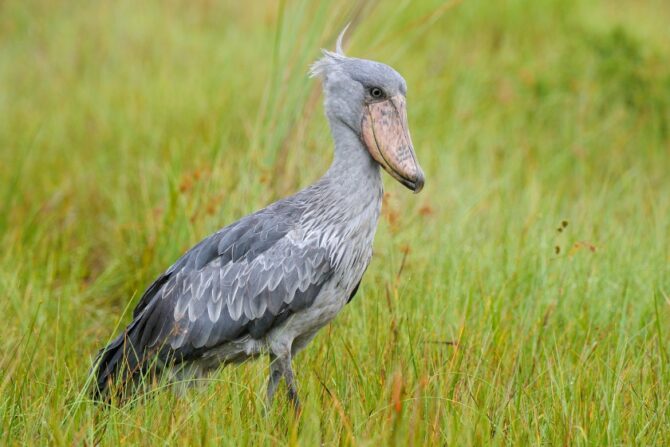
- Scientific Name: Balaeniceps rex
- Length: 43 to 55 inches
- Weight: 8.8 to 15.4 pounds
- Beak Length: 7.4 to 9.4 inches
- Range: East Africa
The shoebill is a member of the Balaeniciptidae family. It is also called the shoe-billed stork, the whale-headed stork, and the whalebill.
It is a bird that’s hard to miss due to its prehistoric looks. It has a blue-grey plumage with thin legs and a long, impressive beak. The shoebill is a native of East Africa.
Only pelicans and storks have beaks longer than the shoebill, giving it the third longest amongst extant birds.
The length gets around 9 inches. This bird is even named after the bill.
Shoebills use their beaks to pick up fish which they swallow whole. Younger creatures start with a short bill which grows as they get older.
5. Hornbill
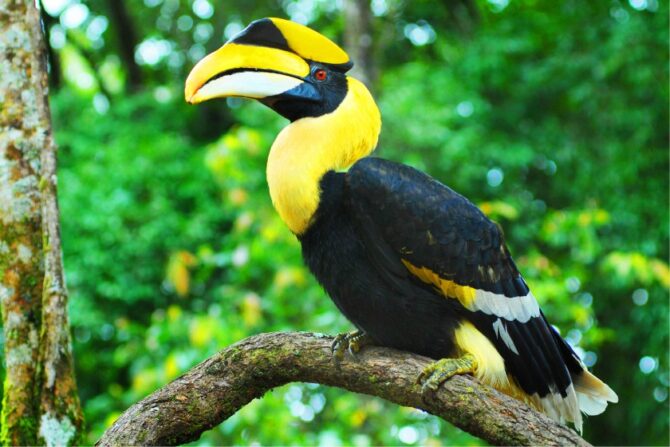
- Scientific Name: Bucerotidae
- Length: 1 ft 1 to 4 ft 3 inches
- Weight: 3.5 ounce to 8.3 pounds
- Beak Length: 17 to 18.5 cm
- Range: Subtropical Africa, Asia, and Melanesia
The hornbill is the common term for the Bucerotidae family, which consists of different species.
Both the scientific name and the common name are inspired by the bird’s unique bill. (The scientific name comes from the Greek term “buceros” which means “Cow horn”).
The bill is its distinct feature. It is long, huge, and strong, being made from keratin. Many species come with a casque on the upper mandible.
The hornbill uses this bill to search for insects in trees, as well as protection from predators.
6. Eagle
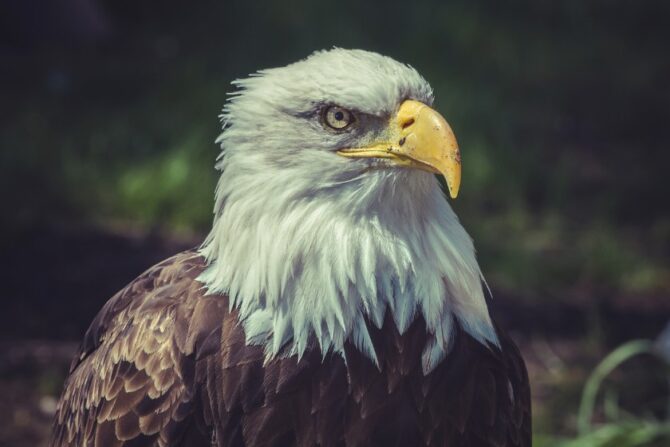
- Scientific Name: Accipitridae
- Length: 40 inches
- Weight: 20 pounds
- Beak Length: 1.6 to 2.69 inches
- Range: Worldwide
The eagle is a common name for birds of prey in the Accipitridae family. There are over 60 eagle species, most of which can be found in Africa and the Eurasian region.
Others are spread across the Americas and Australia. This makes the range worldwide except for Antarctica.
Eagles vary in their size, but they are all big birds. They are proficient hunters as well, taking out prey from a long distance.
Their bodies are adapted to hunting prey. This is why they have sharp claws, a long, curved beak, and strong eyesight.
7. Jabiru
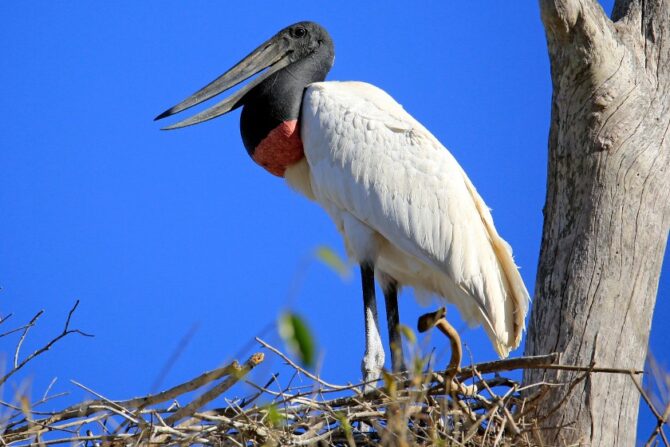
- Scientific Name: Jabiru mycteria
- Length: 47 to 55 inches
- Weight: 9.5 to 19.8 pounds
- Beak Length: 9.8 to 13.8 inches
- Range: Americas
The jabiru is a stork, much like the maribou, and it is a member of the Ciconiidae family.
Its range covers the Americas, and examples of countries it can be found include the United States, Brazil, Mexico, and Argentina.
The name Jabiru means “swollen neck,” inspired by the bird’s neck.
Similar to other storks, the jabiru’s beak is long. It also has thin legs and a plumage that’s both grey and white.
This bird is quite huge, which makes the beak looks even longer. The latter is a good tool for the jabiru’s feeding time.
8. Toucan
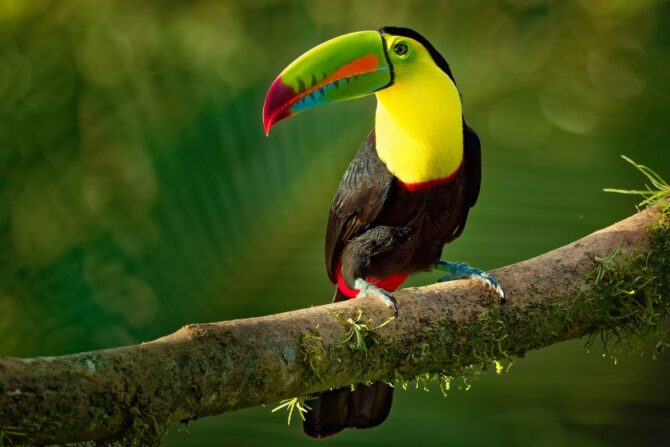
- Scientific Name: Ramphastidae
- Length: 11 to 25 inches
- Weight: 4.6 ounce to 1.50 pounds
- Beak Length: 7 inches
- Range: The Americas
The toucan is the common term for members of the Ramphastidae, well known for their colorful beaks.
There are over 40 species, one of the most popular being the toco toucan. The toucan’s beak is as long as its body, and because of its color it is very visible.
The toucan uses its beak to find food, and the colors serve as camouflage alongside that of the plumage.
It is mainly a frugivore, and the beak serves to pluck out fruit from the tree. Toucans also use their beak as a tool to attract mates.
9. Wood Stork

- Scientific Name: Mycteria americana
- Length: 33 to 45 inches
- Weight: 5.5 to 7.3 pounds
- Beak Length: 10 inches
- Range: The Americas
The wood stork is the only member of the Ciconiidae family that’s a native of North America, where you’d find it in tropical and subtropical habitats.
It can also be found in South America, where it is a resident. It is often found along the coasts.
Similar to other storks, the wood stork has a head bereft of feathers. Its neck bends, and at the end of the face is a long beak.
It uses its beak to feed on carrion. Juveniles have a yellow bill which becomes black as they become adults.
10. Royal Flycatcher
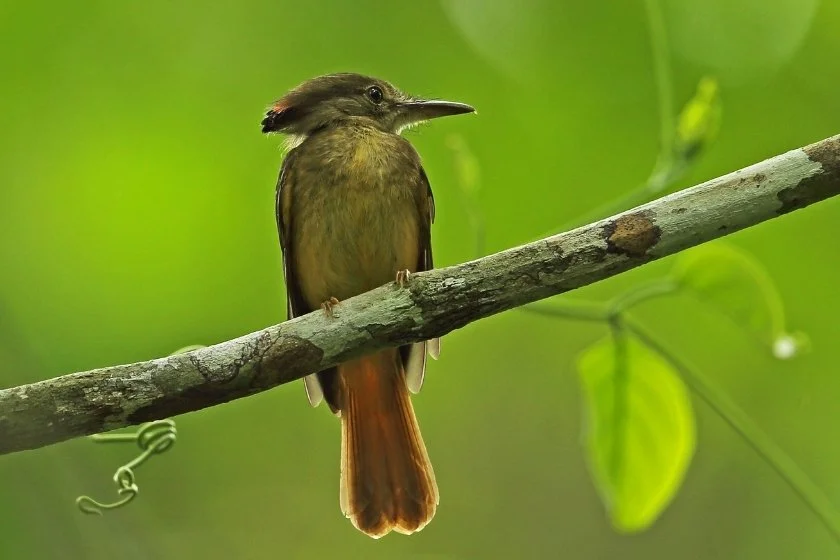
- Scientific Name: Onychorynchus
- Length: 5.9 inches
- Weight: 0.34 to 0.49 ounce
- Range: The Americas
The royal flycatcher is the common name for the genus Onychorynchus which belongs to the family Tityridae.
While some experts take this genus as a species with different subspecies, the common view is it as a genus with 4 species.
It is known for the colorful crest on its head, and it also has a bill that’s “long and broad.”
The royal flycatcher often stays with its beak opened like it was caught in between a yawn. The red throat patch is usually visible when it displays this behavior.
This is the way it defends its territory. It also uses its beak to feed.
11. King Penguin

- Scientific Name: Aptenodytes patagonicus
- Length: 28 to 39 inches
- Weight: 21 to 40 pounds
- Beak Length: 4 to 5 inches
- Range: Antarctica
The king penguin is only smaller than the emperor penguin, making it the second biggest penguin species.
All penguins fall under the Spheniscidae family, including the king penguin. There are two subspecies, both of which are found on subantarctic islands.
Being a large bird, the king penguin has long features, namely the wings, and beak.
The two organs are assets when the king penguin is swimming, looking for fish. It often spends its time hunting at sea but comes to the shore to breed.
12. King Vulture

- Scientific Name: Sarcoramphus papa
- Length: 26 to 32 inches
- Weight: 6 to 10 pounds
- Range: Central and South America
The king vulture is a member of the Carthatidae family, all of which are known as New World Vultures.
It is the only species in its genus Sarcoramphus. The king vulture is a native of Central and South America, going from southern Mexico to northern Argentina.
This creature looks like what you’d expect a vulture to be, complete with a bald neck and head.
The beak is long too. All of these serve to feed on carrion without getting messy.
13. Mother Carey’s Chicken

- Scientific Name: Procellariiformes
- Length: 5.5 to 7.1 inches
- Weight: 0.71 to 1.34 ounces
- Range: Atlantic Ocean
The Mother Carey’s chicken is also known as the storm petrel, a common name that refers to two families under the order Procellariiformes.
These families were once considered the same, but have since been separated. Their specific names are Northern storm petrels and the Southern storm petrels.
Species in these families vary in looks and sizes, but overall they are similar to sparrows, except with short tails.
The bill is heavy and long in comparison to its size but doesn’t seem to do anything except to help it do food.
14. Great White Pelican

- Scientific Name: Pelecanus onocrotalus
- Length: 55 to 71 inches
- Weight: 20 to 33 pounds
- Beak Length: 11.4 to 18.5 inches
- Range: Europe, Asia, Africa
The great white pelican is a member of the Pelecanidae family, and it goes by other names like the rosy pelican, the white pelican, or the eastern white pelican.
This bird is huge, the second largest pelican after the Dalmatian pelican.
The hallmarks of the great white pelican include its white plumage, the broad wings, and the enormously long bill.
It uses the latter to scoop fish from a water body. This is why it has a downward curve at the underside of the beak.
15. South American Tern

- Scientific Name: Sterna hirundinacea
- Length: 16 to 17 inches
- Weight: 0.3 to 0.4 pounds
- Range: South America
The South American tern is a member of the Laridae (tern) family, and as the name shows, the South American tern is Peru, Brazil, and the Falkland Islands.
It is the most popular tern in its range. The South American tern closely resembles its relatives, the common tern, and the Artic tern.
This tern’s bill is long and pointed, a good tool for catching fish, its main diet. The bird lives more above sea, just like the king penguin. It only comes to land to breed.
16. Andean Condor
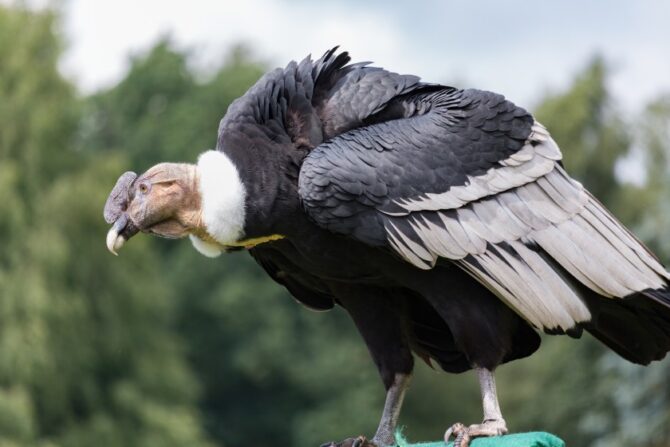
- Scientific Name: Vultur gryphus
- Length: 3 ft 3 to 4 ft 3 inches
- Weight: 33 pounds
- Range: South America
The Andean condor is seen as the largest bird of prey in the world, which is saying a lot considering the number of big birds of prey still alive today.
It is a member of the Cathartidae family and is limited to South America. The Andean condor has since been classified as endangered.
Being the largest bird of prey, it’s no wonder the beak is long. It also has wide wings and an overall black plumage.
Similar to other scavengers on this list, the long bill helps it feed on carrion.
17. American Oystercatcher

- Scientific Name: Haematopus palliatus
- Length: 17 to 20 inches
- Weight: 1.2 pounds
- Range: North America
The American oystercatcher is also known as the American pied oystercatcher. It belongs to the Haematopodidae family, and it is a native of North America.
This bird was termed “oystercatcher” when a naturalist named Mark Catesby discovered that it feeds on oysters. Before now, it was formerly named the sea pie.
Two predominant features of the American oystercatcher are the black-and-white plumage and the long orange beak.
Its beak serves in hunting oysters. It might also come in handy when swimming, as the oystercatcher is a strong swimmer. Though it flies, the oystercatcher prefers staying on land.
18. Greater Painted Snipe
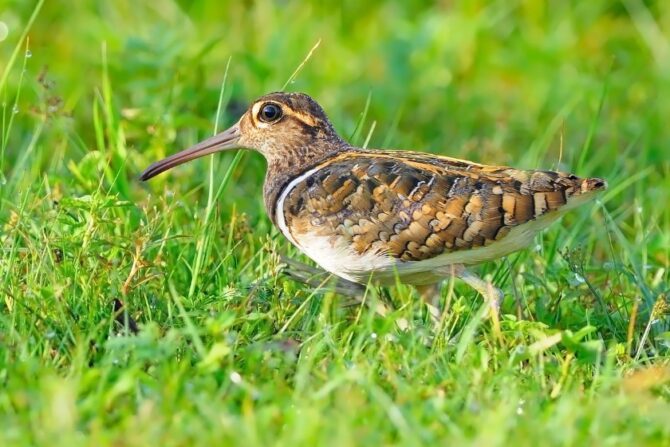
- Scientific Name: Rostratula benghalensis
- Length: 10 to 12 inches
- Weight: 0.3 to 0.57 pounds
- Range: Africa and Asia
The greater painted snipe is a member of the family Rostratulidae, a family of wading birds.
It is a native of Africa and Asia, staying in marshy habitats. It loves staying close to the water as it feeds on fish.
This bird is recognized by its colorful plumage, long legs, tails like a paddle, and a long beak.
The greater painted snipe doesn’t need to step into the water to grab a fish, as it uses the beak as a tool to pick the prey out.
Its plumage serves as a camouflage, so while it hunts, it also protects itself from predators.
19. Arabian Bustard
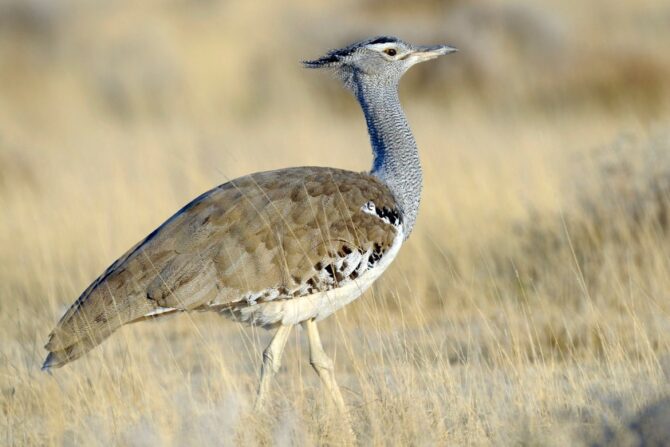
- Scientific Name: Ardeotis arabs
- Length: 28 to 36 inches
- Weight: 9.9 to 24 pounds
- Range: Africa, Arabia
The Arabian bustard is a member of the Otididae family, the bustard family.
This bird lives on the ground and doesn’t fly, much like an ostrich. It is characterized by its long legs, tails, and an equally long beak. It can be found in the Sahel regions of Africa and Arabia.
An elegant bird, the Arabian bustard shows poise in all it does, including feeding.
This is where the long bill comes in handy. It serves to pick snakes, insects, and other prey of the Arabian bustard.
20. Rosy Faced Lovebird
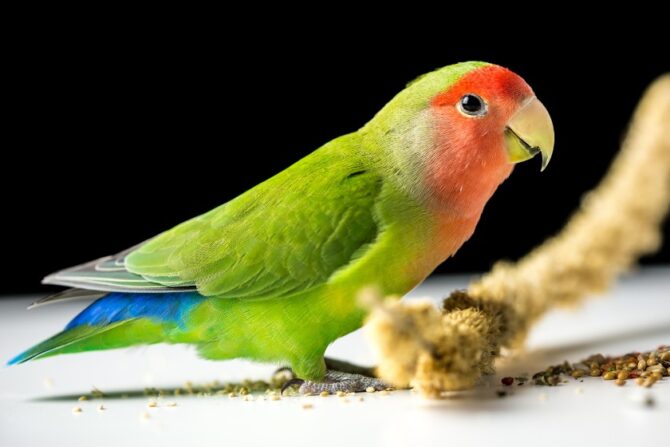
- Scientific Name: Agapornis roseicollis
- Length: 5 to 7 inches
- Weight: 1.2 to 1.5 ounces
- Range: Africa
The rosy faced lovebird is a member of the Psittaculidae family, a family of Old World Parrots.
Alternative names of the rosy faced lovebird include the rosy collared or peach faced lovebird.
It is a native of Africa, where you’d find groups of them chirping away. The rosy faced lovebird is a social animal.
This bird’s beak is long (for its size) and curved down. The beak is a good tool for eating, specifically picking off berries and seeds.
Final Thoughts
Birds with long beaks have them for functional purposes, not just aesthetic. The beaks help them hunt, feed, and even defend themselves from predators.
There are a lot of long-beak birds, more than the ones we’ve collated, but we hope our list served your purpose.



